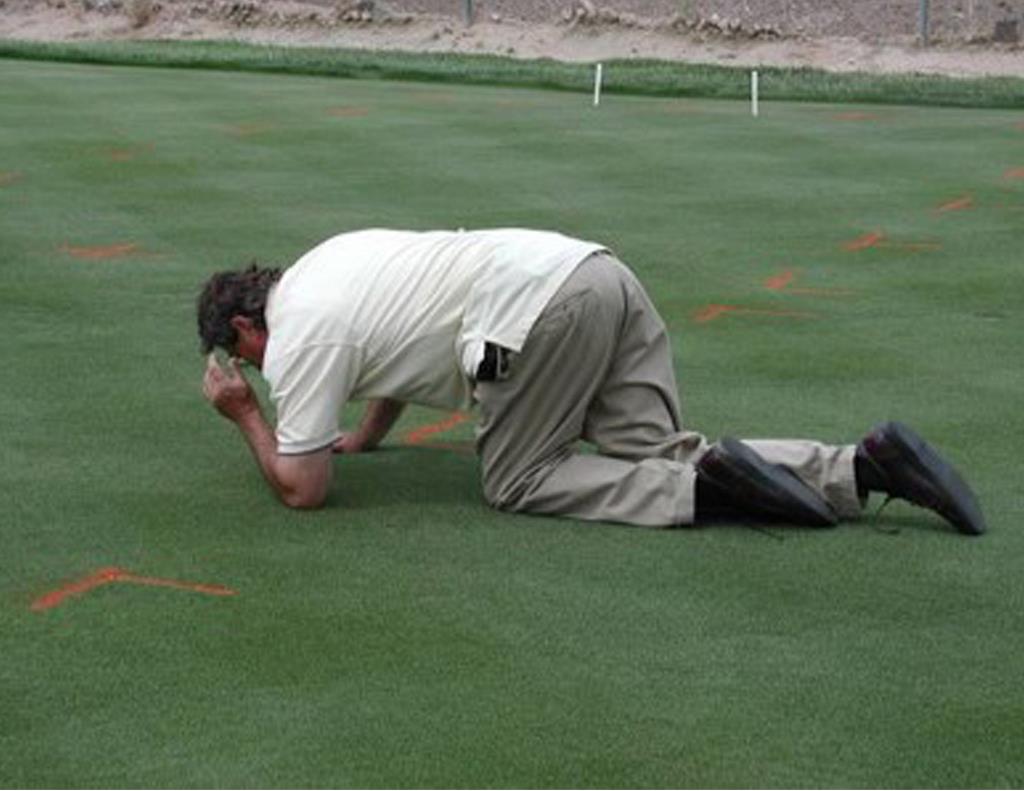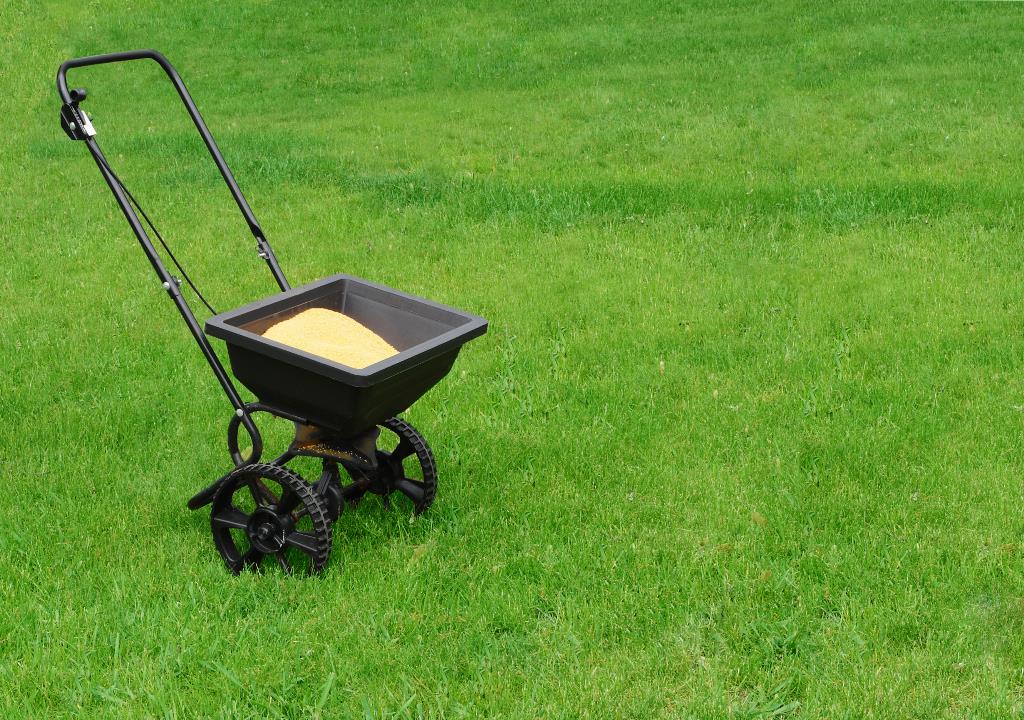Homeowners with lawns appreciate a lush green lawn and are quick to remedy off color or yellow turf with applications of nitrogen fertilizer. However, the lack of green color and the appearance of yellow leaves and stems on turf can be caused by iron deficiency as well.
This issue provides information on how to diagnose and correct nitrogen and iron deficiencies.
Nitrogen and Iron in Plants: After carbon, hydrogen, and oxygen, nitrogen (N) is the most abundant element in plant tissues and is involved in many important chemical processes in plants. Most notable among these is the formation of proteins that are essential for normal growth and the production of leaves, stems, roots and flowers. Turf grown with sufficient nitrogen is often dark green.
In most Arizona soils, nitrogen levels are low due to a lack of soil organic matter. Decomposition of soil organic matter leads to the release of nitrogen that can be utilized by plants. The reason Arizona soils are generally low in nitrogen is natural precipitation is insufficient to support high amounts of plant biomass and warm soil temperatures allow for rapid decomposition of the biomass that is incorporated into the soil.
On the other end of the scale is iron, the other “fertilizer element” that also often causes an increase in green color when applied. Unlike nitrogen, iron is a trace element and is required in only small amounts. Iron is involved in the production of chlorophyll molecules, whose concentration within plant cells is associated with “greenness,” and is essential for photosynthesis and therefore plant growth.
Nitrogen vs. Iron, a plants view!
Nitrogen is a mobile element. It moves inside the plant, from older tissue (lower leaves) to younger tissue (the upper leaves) when nitrogen is limited. When nitrogen becomes deficient in plants the older, lower leaves loose green color and may turn yellow, while the younger leaves remain green. Iron behaves in opposite fashion. Once incorporated into plant tissue, iron is immobile (it does not move). Symptoms of iron deficiency therefore appear on the younger leaves (top leaves) first, while the older leaves retain iron and remain green.
The general overall turf appearance differs with nitrogen and iron deficiencies. With nitrogen deficiency, leaves will show a minimum of two and sometimes three different shades of light green, in swatches across the lawn. There is usually NO yellowing associated with the multiple shades of light green turf present. While on hands and knees, compare the green color of the uppermost (younger leaves) with that of the lower (older) leaves. The lower leaves are lighter in color, sometimes turning to straw. Couple this with the fact that the entire lawn has multiple shades of light green color and you can be relatively sure the turf is nitrogen deficient. Long-term (chronic) nitrogen deficiency results in decreased shoot density, few, if any clippings, poor recovery from traffic, and a near constant production of seed heads (especially in bermudagrass).

In the case of iron deficiency, the initial color change in the lawn can take two forms. At first, the lawn will have a light green cast across its top surface. It may occur in swatches across the lawn, just like a nitrogen deficiency. But now, when you look at the lower leaves, they are darker. The lawn looks like it was sprayed with a lighter color green on the top ½ inch of the grass, while the lower portion of the canopy is a darker green. This is a subtle, but noticeable condition and represents a very slight case of iron chlorosis (without leaf yellowing).
The next phase in the development of a slowly developing iron chlorosis situation is the appearance of yellow color on the youngest leaves at the top of the plant. When true chlorosis sets in, the yellowing of the leaf begins at the tip, and then progresses to the base. When the yellowing is about 2/3rd down that leaf, iron chlorosis begins at the TIP of the next lower leaf. This process follows in leaf age order, and always from leaf tip to leaf base. Note that an iron chlorotic (yellow leaf) turf can occur suddenly, without proceeding through the initial pale green-over darker green condition (very slight iron deficiency) previously described.
Treating an iron deficiency with nitrogen only makes things worse. The greening power of nitrogen will NOT mask an iron deficiency. In fact, it almost always makes it worse. In severely iron chlorotic turf, the addition of nitrogen can produce white leaves and/or leaf death (straw).
Now that you have the diagnostic clues to look for symptoms of “green color problems” on both a “lawn” and on an “individual plant basis,” it’s time for the country doctor test.
If the lawn looks like it is deficient in nitrogen, then apply a small amount of nitrogen fertilizer on a small area and observe the response. Fertilizers such as calcium nitrate or ammonium sulfate can be used. Many “complete” lawn fertilizers (all of which have N-P-K), often contain iron as well. The iron amount is listed on the bag in small letter text, while the N-P-K is listed as the three large print numbers on the face of the fertilizer bag. Make sure to read the entire label. You don’t want to have iron and nitrogen in the same fertilizer source when performing your observational nutrient deficiency test(s). Sprinkler two handfuls of the nitrogen fertilizer in a 10 x 10 feet area, and water in. If the condition goes away in a week or so, then nitrogen was deficient.

If you suspect an iron deficiency, apply ONLY an iron source product. Ferrous sulfate powder is inexpensive and is applied as a spray solution. (Do not use ferrous ammonium sulfate, as it contains nitrogen. Mix one teaspoon in 1/2 gallon of water, and spray the entire solution over a 15 X 15 feet area, until all the solution has been applied. Let the iron sit on the leaves for 24 hours before mowing or irrigating the lawn. This allows for leaf uptake. In a few days (in hot weather) you will see if the 3 diagnostic response is positive (yellow starts to disappear), or not. If the response is positive, apply iron across the entire lawn according to the label directions. Ferrous sulfate cures iron chlorosis for about 3 weeks or so. After that, soil pH ties up the iron and makes it unavailable to the plant. Thus another application is often necessary.
More expensive, but longer lasting iron compounds are commercially available, usually referred to as iron chelates. When shopping for a chelated iron, check the label for the soil pH range over which the iron will be available. Arizona soils can have pH values of 8.2 or greater.
Trace element fertilizer mixes contain iron, but they also contain manganese, zinc and other elements. Using a full trace element may correct the chlorosis, but you cannot say for sure what trace element the actual deficiency was caused by.